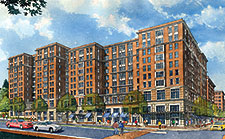More Students and Less Capital Funding Push Innovative Housing
Even as tuition skyrockets at many U.S. universities, enrollment is keeping pace, creating larger student bodies that are less inclined to accept cramped and aging dormitories. To accommodate and lure students with top-quality housing stock built faster and more economically, schools are embracing private developers as partners. Public universities facing cuts in state funding already are on the bandwagon, and private schools also are seeing more benefit in the privatization approach.
California is a privatized housing hot spot. In the next five years alone, California colleges expect another 800,000 students. At the University of California campus in Irvine, American Campus Communities Inc., an Austin, Texas-based real estate investment trust, is developing Vista del Campo, a $73-million, 1,564-bed project. Set for completion next year, it follows a 1,488-bed first phase completed in 2004.
 |  |
| Expedited. Kutztown University foundation completed housing in 12 months. (Photos courtesy of Kutztown University Foundation) | |
Because Vista del Campo will compete with nearby apartments for student tenants, it includes amenities not typical in a college dorm, such as game rooms, a fitness center and a pool, says Jason Wills, the developers senior vice president of marketing and business development.
Tighter funds prompted the University of Georgia to choose a privatized approach in 2001 for a $100-million housing project on its East Campus that opened last fall. Obtaining school funding would take too long, says Jim Day, executive director of university housing. "Georgia hasnt had a revenue bond active for some decades," he says. "Once this privatized method was brought to Georgia, it has become the method exclusively used for college housing."
 |
 |
| New Look. University of California project under construction will offer recreation facilities. (Photos courtesy of American Campus Communities) |
University officials worked through the schools nonprofit real estate foundation to secure tax-exempt bonds for the 1,220-bed, four-building apartment complex. The projects university-owned property is leased to the foundation, which in turn owns the improvements and leases them back to the school to operate and manage. Developer Ambling Development Inc., Valdosta, Ga., and builder Choate Construction, Atlanta, handled only design and construction.
Privatized housing is not just for big schools. Kutztown University of Pennsylvania, a public college in the states Amish country with about 7,200 students, completed a $20-million, 549-bed facility last fall. Robert Kempf, the school foundations chief financial officer, estimates the privatized project was one-third less expensive and faster than if university-run. From conception to occupation, the project took 12 months. "It probably would have taken the state four or five years to do that," he says.
Public institutions account for most of the market, largely because many states have been reducing funds for residence halls. But private schools also turn to developers to realize housing projects.
Johns Hopkins University, Baltimore, is working with Birmingham, Ala.-based Capstone Development Corp. and local developer Struever Bros., Eccles & Rouse, to build Charles Commons, a $71.4-million facility near campus. Developers will own 29,000 sq ft of ground floor retail space, while the university will own and manage residential space. To be completed in September 2006, the complex will help provide on-campus housing to all 4,000 undergrads and revitalize the surrounding area, says David McDonough, senior director of development oversight for Johns Hopkins Real Estate.
Flexibility
Several student housing development firms, including Capstone, started a decade ago buying property near expanding universities and building affordable apartments. Universities could satisfy the need for more housing and preserve debt capacity for other capital projects. "In the initial days of our efforts, a lot of the perceived advantage was that...universities didnt have to use their own borrowing capacity or state money," says Jeff Jones, Capstone executive vice president.
Lately, relationships between universities and developers have become more flexible. Various scenarios involve different levels of involvement, risk, and profit sharing between the two groups.
 |
| Shared. Developer will own ground floor of this Johns Hopkins housing project. (Photo courtesy of Capstone Development) |
Many projects rely on a third party for financing, such as a non-profit foundation acting as the universitys fundraising arm. When the project is done, the school owns the land, the foundation owns the building and the developer is paid for building the project. When bonds are paid off, usually after 30 years, the foundation gives the building to the school.
A developer also may partially finance and then manage residence halls. Seattle developer Lorig Associates will pay $10 million of costs in exchange for a 50-year lease on a $17.1-million, 129-unit apartment complex at the University of Washington, Tacoma.
Universities have few complaints about third-parties. But Day offers advice: Developers typically are concerned with first costs, he says. But long-term owners are more likely to invest in features that will lower life-cycle costs like better quality windows. "You really need someone on the owners team that understands this kind of construction and can help make tough decisions. We made some decisions to spend more money on certain aspects of these buildings. Already we are seeing the benefits."
